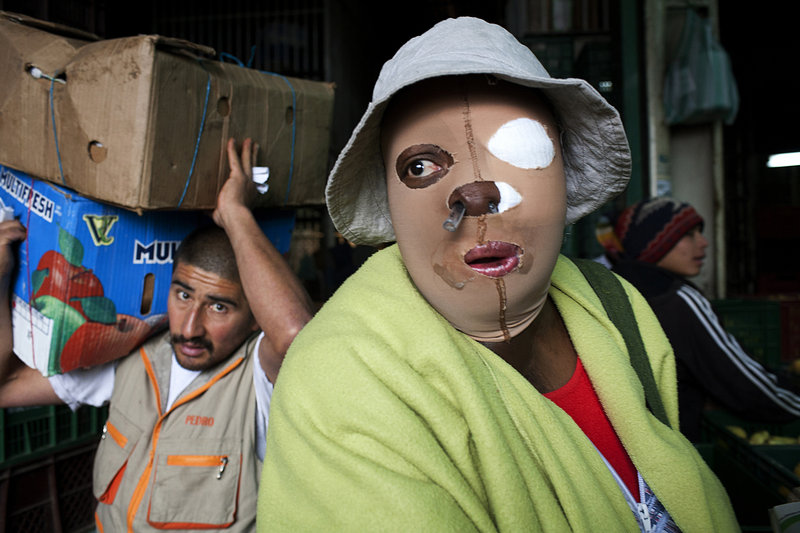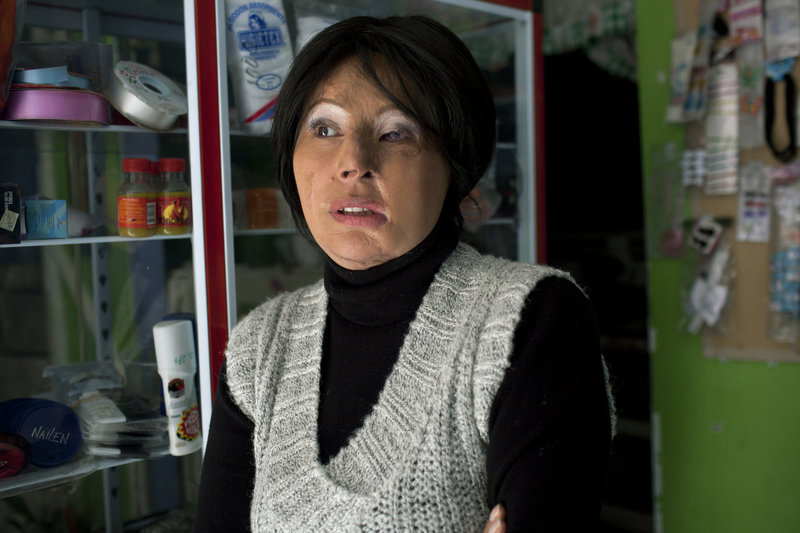BOGOTA, Colombia – Every glance at a mirror transports Consuelo Cordoba to the moment when her boyfriend doused her with a skin-searing acid that obliterated her face, leaving her with gruesome wounds that will never heal.
The chemical burned off an ear, melted an eye, ate through her lower face and ruined her teeth. She now wears a skin-tight elastic mask, breathes through a straw-like tube that protrudes from her nose and walks the streets looking “like a monster,” as she put it.
“I would like to go to sleep today and not wake up tomorrow,” she said. “The truth is life is too hard and I am alone.”
A cheap and quick way of destroying a woman’s life, acid attacks in India, Afghanistan and Bangladesh have received widespread attention in recent years, with a documentary about victims in Pakistan winning an Oscar this year.
While the gruesome assaults have been rare in the West, a rising number of attacks in Colombia has alarmed prosecutors and public health officials and terrified women. Dozens of such attacks, in which assailants soak their victims with sulfuric or nitric acids, are believed to take place here each year.
The precise reason for the spike here — and not in, say, neighboring Peru — is not known. But women’s rights advocates in Colombia talk about an epidemic of violence against women. They range from spouse-battering cases so extreme that they make the nightly news to reports of illegal armed groups using rape as a weapon in a murky rural conflict.
“Sometimes in the West we make fast judgments and say, ‘Look how terrible they treat women in the East,’ and we don’t look first at ourselves,” said Monica Roa, the Bogota-based international programs director of Women’s Link Worldwide, a rights group.
“The violence here may be different, but it emanates from the same place. This is a culture where machismo reigns, where men do what they want to do.”
If a woman is attacked over a dowry in India or because she ventured outside without a veil in Pakistan, in Colombia a woman might be attacked because of sheer rage over her independence or even by a disturbed man she doesn’t know.
That’s what happened in 2004 to Maria Cuervo when a complete stranger shouted, “This is so you don’t think you’re so pretty” and drenched her face with acid.
Mostly, though, a jilted boyfriend or a husband intoxicated with jealousy is behind the attack.
“He had hit me because of jealousy, so I ended it,” Erica Vanessa Vargas, a slight, soft-spoken woman of 20, said of the day she ended her relationship with a boyfriend four years ago. “He then said, ‘If you’re not mine, than no one will have you.’“
Her former boyfriend paid a small boy $1.75 to throw acid at her — changing the course of a young life. “I stopped going to school, I can’t work, I can’t depend on my own self,” said Vargas, wearing a scarf to shield her scarred neck and chin.
The statistics on acid attacks are hazy in Colombia, as in other countries where they take place.
Bogota city councilwoman Olga Rubio, a victims’ advocate, said about 100 of the assaults have taken place so far this year across Colombia. It is a pace that would easily surpass last year’s total of 150.
The state’s forensic science institute registers more than eight cases a month, though most involve male victims, many of whom were assaulted by muggers using acid as a weapon. The attorney general’s office, meanwhile, said it is investigating 56 cases, 36 of them involving women.
But Attorney General Eduardo Montealegre said he believes “a considerable volume of crimes and aggressions are not reported.”
“Experience shows that what’s reported does not correspond to reality,” he said, explaining that victims are sometimes attacked by relatives and fear coming forward.
Noting an increase in acid attacks, Montealegre said he is creating a new team of prosecutors and crime-scene experts to investigate the crimes. The team would also determine whether authorities have inadvertently downgraded the gravity of reported acid attacks, instead of cataloguing some of them as attempted homicides.
The perpetrators often receive no jail time because the attacks are treated as minor assaults, said Sen. Carlos Baena.
“The punishment is very light and doesn’t take into account the very dramatic pain that the victim has to go through,” said Baena, who is sponsoring a bill to impose at least a 20-year prison term on convicted attackers.
He and the city councilwoman, Rubio, are also proposing regulations to require buyers of acids to register their purchase.
Such reforms might have an impact. The number of attacks in Bangladesh fell from about 500 a year a decade ago to about 100 a year after that country imposed tougher sentencing guidelines and began to register acid sales, said Jaf Shah, the executive director of London-based Acid Survivors Trust International.
Health care providers describe a heinous crime that can literally wipe away a victim’s face.
Linda Guerrero, director of the Foundation for the Burned, which provides plastic surgery, physical therapy and psychological assistance to victims, said the chemicals in the acids corrode the proteins in facial skin and sear through delicate tissue.
“It’s the worst thing that can happen to your skin,” she said.en away.”
Send questions/comments to the editors.




Success. Please wait for the page to reload. If the page does not reload within 5 seconds, please refresh the page.
Enter your email and password to access comments.
Hi, to comment on stories you must . This profile is in addition to your subscription and website login.
Already have a commenting profile? .
Invalid username/password.
Please check your email to confirm and complete your registration.
Only subscribers are eligible to post comments. Please subscribe or login first for digital access. Here’s why.
Use the form below to reset your password. When you've submitted your account email, we will send an email with a reset code.